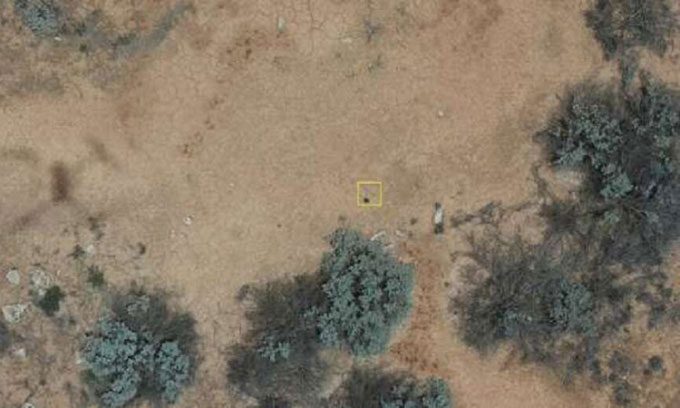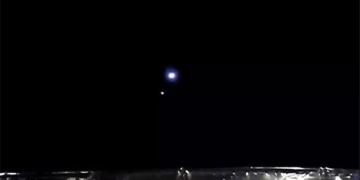Thanks to a new method, a 70-gram fragment that fell in Western Australia was found just 4 days after the meteorite crashed to Earth.
For the first time, experts used sky observation cameras combined with drones to locate the meteorite fragment, marking a new era in accessing information about the Solar System, IFL Science reported on March 16.

Drone image showing an area in the desert with the meteorite fragment marked within a 22cm frame. (Photo: Seamus Anderson)
Humans spend billions of dollars sending spacecraft to distant asteroids to collect samples for analysis. Occasionally, fragments from asteroids also come to us in the form of meteorites crashing to Earth. However, most meteorite fragments available for study have been on the ground for a long time and are no longer pristine as experts would like.
Planetary scientists have established several networks of cameras to track the trajectory of meteorites in hopes of finding fragments faster. Last year, they upgraded the system by adding drones. The success in accurately pinpointing and locating the meteorite in a remote area of Australia was published in the journal Astrophysical Journal Letters.
Just 4 days after the Desert Fireball Network (DFN) captured the first images of a meteorite entering Earth’s atmosphere, scientists found a 70-gram fragment in Western Nullarbor, Western Australia, just 50 meters from the calculated trajectory.
The DFN was established to enhance the ability to detect meteorite fragments while providing numerous images of their journey. This network takes advantage of the vast areas of Australia, which benefit from a lack of artificial light affecting the photographs and also have minimal vegetation obstructing the search for fallen meteorites.
On April 1 last year, the DFN recorded a very bright meteor streaking across the sky. Researcher Seamus Anderson at Curtin University and co-authors of the new study noted that the brightness was so intense that a part of the meteorite likely fell to the ground. They used camera images to create a search area of 5.1 square kilometers on the expansive Nullarbor Plain in Western Australia.
“A camera-equipped drone flew over and collected images of the fall area, which were then sent to our computer. There, an algorithm scanned each image to find meteorite fragments and objects resembling them. Although the algorithm was ‘trained’ based on data from previous meteorite searches, we also brought along old meteorite fragments and photographed them on the ground at the fall site to create local data for further training,” Anderson explained.
This work requires about 10% of the manpower needed for a typical meteorite search—an important saving when working in a remote location under the intense heat of Australia. However, the process was not entirely smooth as scientists also encountered “false positives” such as tin cans, bottles, snakes, kangaroos, and bones from various animals.
Anderson stated that this was the eighth meteorite recovered thanks to the DFN, but it was the first meteorite found using a drone. Preliminary analysis indicates it is an H-chondrite, a fairly common type of meteorite. However, the successful application of this new method will pave the way for the search for rarer meteorites.





















































